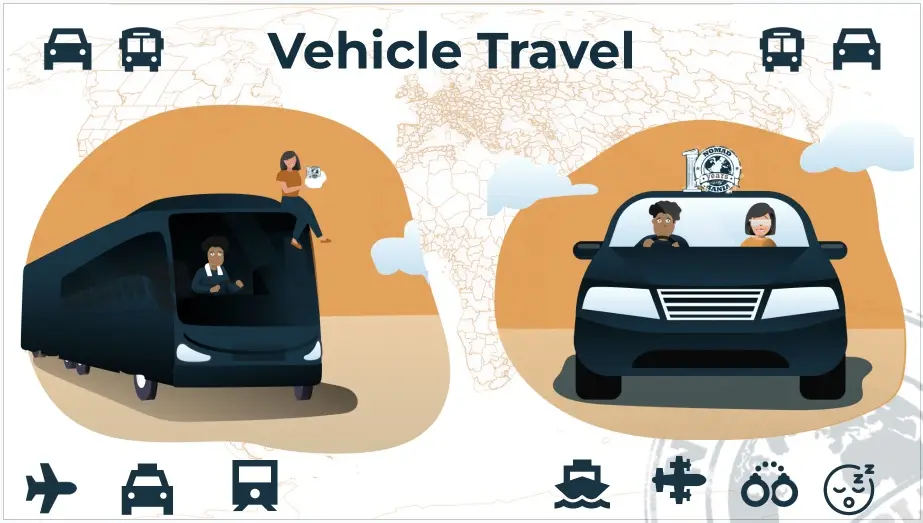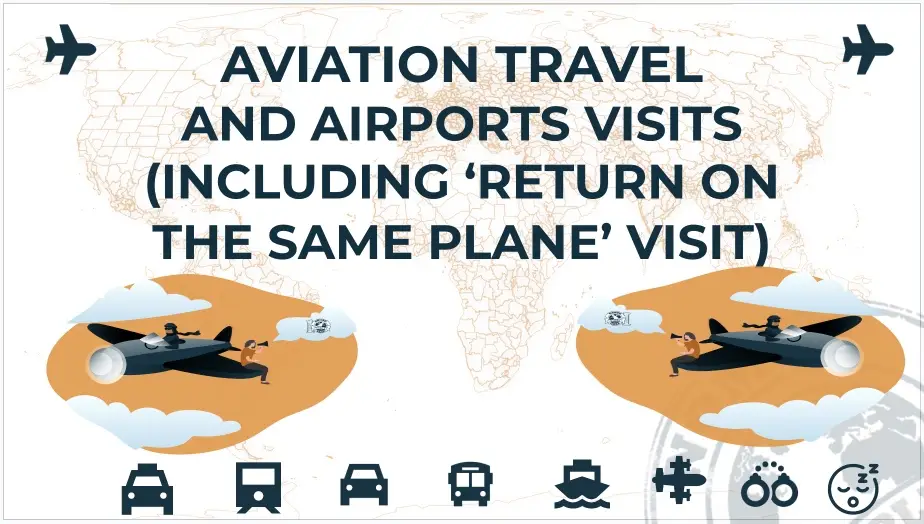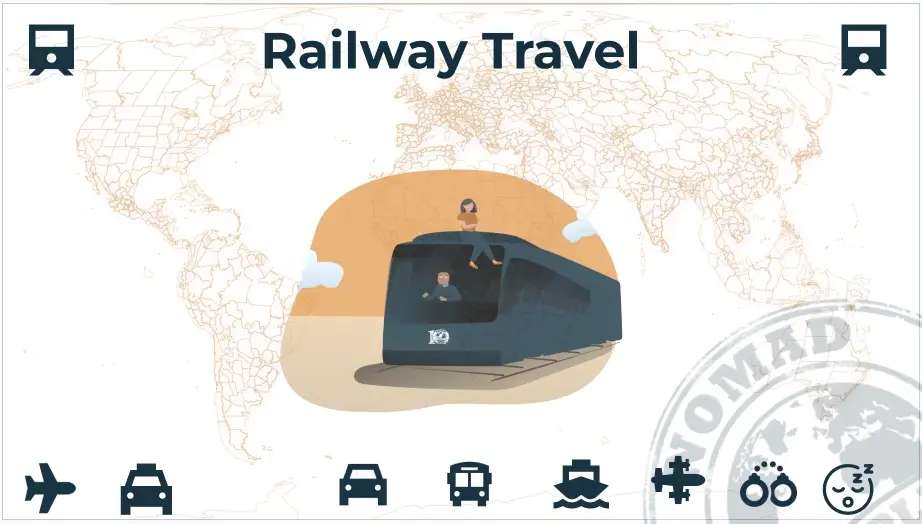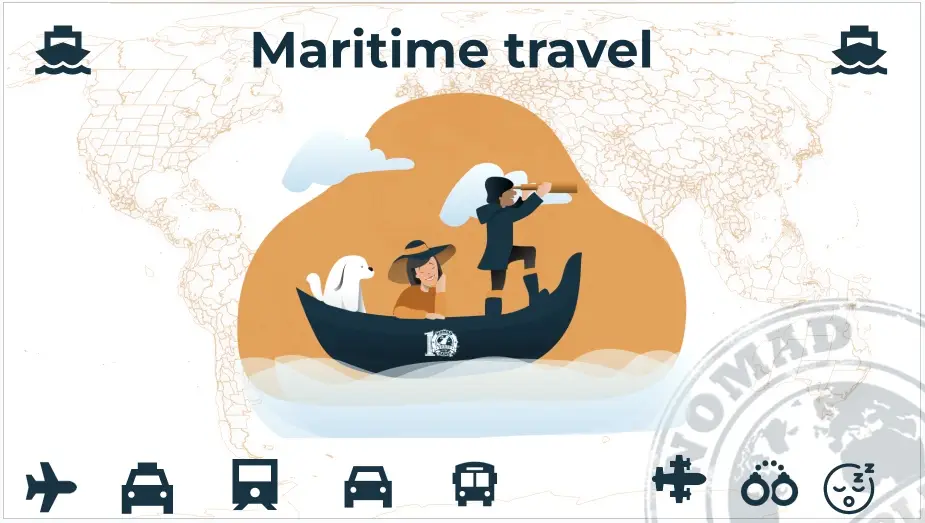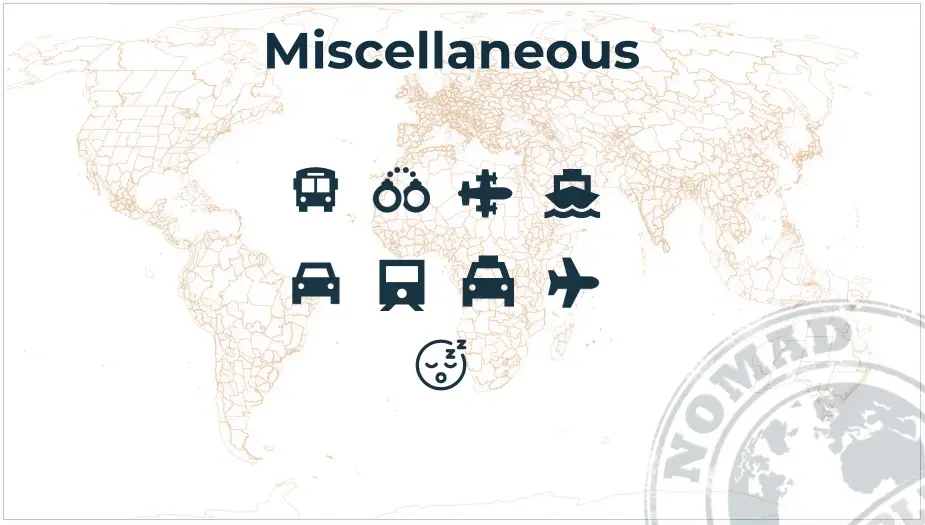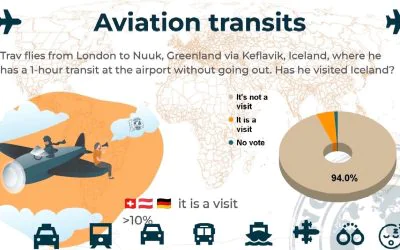The issue of ‘what is a visit’ has been one of disagreement among travellers for a considerable amount of time. Different organisations have distinct rules, resulting in unclear criteria which can result in very unfair outcomes when comparing travellers’ travel claims.
NomadMania has tried to codify the rules for a ‘minimal visit’. Please note that this relates only to the concept of ‘minimal’. As a rule, and a promoter of good travel, NomadMania always wishes for ‘good visits’, where countries and regions are experienced fully and for long periods of time. Nevertheless, it is important to also create standard rules as to minimal visits which are applied to all.
Welcome to watch a webinar with in-dept explanations.
Or simply read the guidelines below.
NomadMania conducted two polls of its users, held in the summer of 2022 and the winter of 2023 respectively.
In the first poll, almost 1000 travellers voted; in the second more than 800. Following the results, NomadMania has decided to honour the majorities precisely, even when these were by a margin of few votes. On the rare occasions when questions within the same scenario yielded diverging outcomes between the first and second poll, the results of the second poll, as more recent, are considered.
We trust that the rules below will now be used in all cases to help decision-making for travellers in terms of whether a region can or cannot be claimed as ‘minimally visited’. These now codifed rules will from now on also inform NomadMania’s Verification efforts. Regions can no longer be claimed as visited if the criteria for ‘minimal visit’ as outlined below are not satisfied.
Note: For the benefit of visually impaired travellers, we are replacing the word ‘seeing’ with ‘sensing’, which we deem more inclusive.
SECTION 1 – VEHICLE TRAVEL
The rules involving vehicle travel are rather complex. NomadMania is, based on the vote of its own travellers, breaking the long-standing requirement to ‘touch the ground’ of a region which has been held as a general criterion so far. Please read below.
Specifically:
- Crossing a mere borderline (and then returning), without any further experience, does not count as a minimal visit to a country/region. It is clear from the results of the polls that our community requires more than just a ‘step in’ to accept a minimal visit. This implies the need for a ‘memorable experience’ beyond a borderline/customs office/invisible line on the ground. We are unable to precisely define what this experience is; it should ideally involve either locals (not officials/border officers) and/or a sight of cultural or natural significance.
- Being in a country or region without stopping and without having a notable experience while in a vehicle does not count as a minimal visit, regardless of consciousness or whether the trip is during day or night – rejected by 89%
- Being in a country or region, stopping very briefly at a gas station or at a pit-stop, whether getting out of the vehicle or not, also does not count as a minimal visit – rejected by 60-72%
- Being in a country or region and stopping only at the transport hub (i.e. bus station) does not count as a minimal visit – rejected by 70%; also not if a very brief moment is spent outside the transport hub sensing something minor – rejected by 52%.
However, the following DO count as minimal visits:
- Being in a country or region and stopping briefly to have an experience of a cultural or natural sight of significance does count as a minimal visit (for example, stopping to photograph an archaeological site or a major mountain by the road) – this was accepted by 70%
- Being in a country or region and experiencing a cultural or natural sight of significance in a private vehicle – not public transport – does count as a minimal visit even if the traveller has not been outside the vehicle i.e. has not ‘touched the ground’. This was accepted by 63-76% based on different scenarios.
- In the case of public transport vehicles (coach, shared taxi etc.), the same rules as railway transport (see section III below) apply; for example, leaving the bus station for 10 minutes and sensing some significant landmark of the area or entering a shop is accepted as a visit by 50.4%-84% depending on the scenario. However, for public transport, a sine qua non is to ‘touch the ground’ in all cases.
SECTION 2 – AVIATION TRAVEL AND AIRPORTS VISITS
(INCLUDING ‘RETURN ON THE SAME PLANE’ VISIT)
In all instances, so-called ‘visits’ involving airports are rejected as a minimum visit to a country, irrespective whether immigration is crossed or not. This includes:
- Going through a country without crossing immigration – 95% rejection rate. This is the case even if considerable cultural activities are present at the airport area.
- Crossing immigration but staying in the greater airport area – 85% rejection rate
- Leaving the airport area and having a very short time without a significant cultural or natural sight experienced near the airport area before a further flight – 61% rejection rate
- Going through a (domestic) region without leaving the airport (see below for an exception) – 92% rejection rate
- Going through a (domestic) region and staying in the general airport area or leaving the airport for a very short experience near the airport – 74% and 63% rejection rate
- Overflights – 87% rejection rate
This implies that claims of the type ‘going and returning on the same flight’ which do not involve taking a vehicle and leaving the entire airport vicinity for a reasonable amount of time are rejected as visits in all cases. UN country claims cannot count as a minimal visit when the departure is on the same plane as the arrival, merely crossing immigration and back again with a very short time in the airport vicinity. Returning on the same plane can only be accepted as a minimal visit where a traveller successfully takes a vehicle well beyond the airport area and has a significant experience (sensing a major sight or interacting with locals).
The only exception to the aviation rule regards visits to regions, not countries. If an extremely small regional airport, with no facilities/security check etc., which is not an international entry/exit point to the country, is experienced and the stop involves a stay on the ground which includes a cultural experience and considerable interaction with locals, then this can be construed as a minimal visit to the region. This was supported by 62% of respondents.
SECTION 3 – RAILWAY TRAVEL
The picture is more complex with railways. A sine qua non for all railway travel is, as a minimum, stepping into the region. In other words, not getting off the train can never be considered a minimal visit.
What emerges is that experiencing a noteworthy element of a region – including architecture or a shop – beyond a station/railway hub, even for a short amount of time, is accepted as a minimal visit. For example, leaving the station for 10 minutes and sensing some significant landmark of the area or entering a shop is accepted as a minimal visit by 55%.
However, the following are rejected as minimal visits:
- Train experiences where a region is seen through the train window, regardless of whether a traveller is asleep or awake and anytime during the day or night – rejected by 82 – 90% in different scenarios.
- ‘Stepping’ into the region within the train station area only (platform or station) – rejected by 75%
- A quick ‘stepping’ into the region even beyond the train station area when this only involves a look with no significant experience or cultural/natural sights seen – rejected by 56%
SECTION 4 – MARITIME TRAVEL
- In terms of inhabited countries and regions, sensing from a vessel alone is not accepted as a visit, no matter how close the distance to the land is, or even if the vessel is moored. Such situations are rejected by 69%-89%. However, see below the case of river visits when both banks of the river are in the same country/region.
- Being at the port area only, regardless of the extent of the port, is ultimately rejected by 57% (in the first poll, this was rejected by 47% only). A visit to the port is rejected even if there are considerable cultural activities going on there – rejected by 57%.
However, the following are accepted as visits to a country/region:
- Leaving the port area, even a little bit, is accepted as a visit – accepted by 60% even in the most minimal departure from the port. This contradicts the stricter principle of railway and vehicle travel, however, the argument can be made that boat travel by definition is often ‘freer’ and outdoors, and results in a better understanding of a place.
- In the event that there is no established port area, ‘putting a foot’ on the region when disembarking the vessel is considered a minimal visit.
- The closest results were regarding situations where a country/region is experienced from a vessel in a river. Ultimately, with a very thin margin, NomadMania will accept this as a minimal visit provided both banks of the river are in the same country/region and the sights experienced are significant (i.e. not just landscape itself) or involve locals. This was ultimately accepted by 51% (in the first poll, accepted by 49.5%). Note that if the river is an international border (i.e. parts of the Danube between Bulgaria and Romania etc.), no visitation claims can be made to either side, nor can visitation claims be made if the river is the border between two NomadMania regions.
We will differentiate between inhabited and uninhabited regions in terms of maritime travel to align with the results of our polls. NomadMania defines inhabited regions as areas where essential elements of society are present in a permanent way not related to people’s occupation; elements of society are, for example, families, children etc. Areas where ‘society’ as defined above is not present, for example where there is only military or clergy, are deemed ‘uninhabited’ for NomadMania.
Please note, based on the definition above, that the only uninhabited regions still on the NomadMania Masterlist are in the Antarctic and Arctic megaregions as well as Mount Athos in the Southern Europe megaregion; however, NomadMania’s M@P listing is full of uninhabited regions which can be claimed provided the nature ambience of a region has been sensed fully.
Sensing an uninhabited region from a vessel at a close distance which allows a good understanding of the natural ambience is considered a visit – accepted by 52%. Sensing from a distance whereby the geography is unclear or merely ‘glimpsing’ the region from afar do not count, however. This criterion is by definition weather-related as well; for example, in the event of deep fog where the island cannot be sensed, this will not count as a visit. For travellers with impaired vision, the ability to feel and understand the ambience of the island is paramount; for example, sailing on a zodiac close to the shore where animals can be heard etc. implies an understanding of the ambience.
SECTION 5 – MISCELLANEOUS
The following rules are also valid:
Illegal visits, subject to the rules above, are considered legitimate visits – accepted by 79%. In other words, the legality or not of the visit is not of concern.
- Example: Crossing the border to Guinea from Liberia illegally at a river and visiting the closest village in Guinea, then going back, is accepted as a minimal visit; however just touching the ground in Guinea, without any interaction or cultural experience, is not considered a minimal visit as per the rules outlined in Section I.
Consciousness is essential for a minimal visit to be claimed. Being unconscious or with considerably impaired consciousness (i.e. too drunk to recall) renders a visit unacceptable – rejected by 50.2% – 63% depending on the scenario.
- Further Example: Being in a region while asleep, even if the above rules in I-IV are followed, can never count as a minimal visit.
Travel for business meetings where nothing else is experienced is still a minimal visit – accepted by 71%.
- Example: Landing in Bishkek, taking a taxi to an office, having a meeting and then returning to the airport to leave does count as a minimal visit.
Similarly, travel where only a night (i.e. at hotel sleeping for example) is experienced and nothing else, is still accepted as a minimal visit – accepted by 61%.
- However, this is not acceptable for a hotel within the airport area, as being within an airport area is always rejected as a minimal visit, even if it is for the entire night.
Following our rule of vehicle/land travel, just crossing a line is rejected. This is especially relevant for the case of the DMZ which cannot be used to claim a visit to North Korea – rejected by 83%. We specifically mention this as many travellers seem to consider the DMZ experience a legitimate visit – for NomadMania, it is not.
Similarly, in the event of contested sovereignty, visiting an area under control of one country – recognised or not – can in no circumstances be used to claim a visit to another country which has no control of the area even if it has de jure sovereignty; this is for example the case for the Golan Heights when visited from Israel, which cannot be used to claim a visit to Syria – rejected by 88%. A further example of Armenia/Azerbaijan exclaves was rejected by 62%. We will extrapolate these, therefore, to most cases of contested sovereignty.
This implies that when claiming a visit to a UN country, a visit must be made to an area of control of the government of the UN country itself, not a foreign/alternate authority (often not a UN country). We will make exceptions for the cases of Somaliland (which will count as Somalia) as well as Eastern Libya (which we will accept as a visit to Libya despite the current – 2023 – dual government) due to the cultural proximity of the places in question.
However, a visit to, for example, Abkhazia alone will not count as a visit to Georgia; a visit to Kosovo alone will not count as a visit to Serbia; a visit to Taiwan alone will not count as a visit to China. Please note that this rule in no way implies NomadMania is taking a political stand on any issues of contested sovereignty; NomadMania merely wishes to ensure that cultural aspects that constitute a UN country are fully experienced as they are exhibited within areas fully under said country’s control.
Finally, leased areas under the management of corporations are still considered a minimal visit to the country/region where overall sovereignty over the territory lies – in the example of Labadee in Haiti, this was accepted as a visit by 55%.
SECTION 6 – SERIES
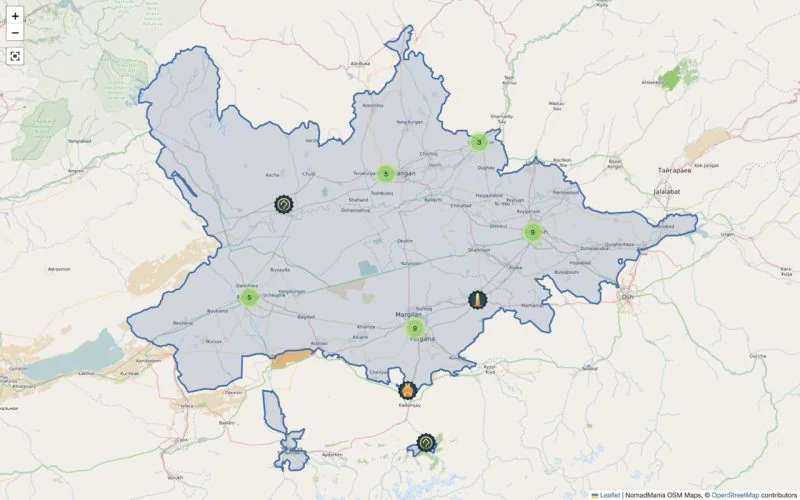
Vestiges of the Past can vary. The common sense prevails. If you can see enough from the outside without buying a ticket, that should count.
Please note that the transport series works differently – you must USE the transport hub. So, going to an airport to meet a friend does not count for ticking the airport. Same for train stations; you must use them i.e. board a plane or get off a plane or board a train etc. Same for borders – you must cross the border to tick it, not just see it.

